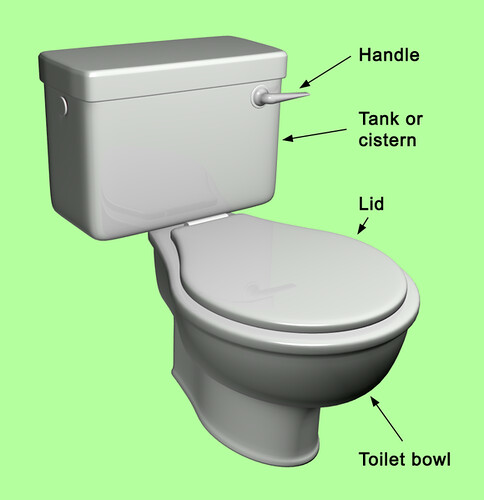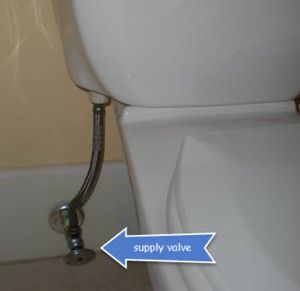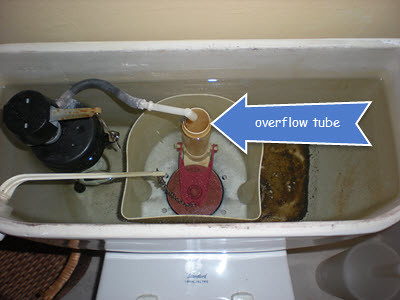Do you have a sluggish toilet? Do you find yourself standing, hand poised on the lever, while the contents make a few leisurely circuits of the bowl before slowing to a halt? Does it take two, three, even four flushes to finish each trip to the porcelain facility? If you answered "Yes" to any of these questions, you may have a sluggish toilet. The good news is that if you're reasonably handy, you may not need to call a plumber to get things working right.
|
|
Diagnosing a Slow-Flushing Toilet
The key to recognizing a sluggish commode is that the condition usually develops slowly instead of overnight. Even if that's the case, before diving into this project run a simple test. Fill a bucket or large pan with about a gallon of water. Dump the water into the bowl: don't do this gently, just upend the bucket to get the water in as fast as possible. If your toilet still doesn't flush, you probably have a blockage that requires cleaning out the sewer line. If flushing looks normal, your toilet is just sluggish.
|

Under the rim of the toilet you'll find a line of jet holes completely circling the bowl. The holes are all angled in one direction, which is why water in the bowl swirls counterclockwise when you flush. Over time, the jet holes can become partially or completely clogged with mineral deposits and other gunk. You may be able to resuscitate your commode by cleaning these jets. A bent wire clothes hanger may be all you need, along with rubber gloves and a mirror -- the better to see under the rim. Once you've probed all the holes thoroughly, toss a few sheets of tissue in the bowl and flush. If it's still sluggish, it's time to bring out the big guns.
The Acid Method
What You'll Need
- Large sponge
- Bucket
- Small plastic funnel
- Rubber gloves
|
|
- Safety glasses
- Muriatic acid (one gallon)
- Self-stick plastic wrap
- Newspaper, rubber bands, masking tape
|
Start with a trip to a hardware or pool supply store, where you'll pick up a gallon of muriatic acid. Also known as hydrochloric acid, muriatic acid id most commonly used to balance the pH of swimming pools and to clean masonry. Muriatic acid is unpleasant stuff, so handle it with care and keep it away from children and pets. While you're at the store, pick up a plastic funnel and, if you don't already have some, safety glasses. Assemble your tools in the bathroom: beside the acid and the funnel, you'll want gloves and safety glasses, a sponge, a bucket, a roll of plastic wrap and some newspaper. Now you're ready.
Step by Step

- Turn off the water supply to the tank (look for a valve on the supply line left of and below the tank). Flush once to empty both the bowl and the tank. Sponge as much water as possible from the bowl into your bucket.
- Remove the top of the tank and set it to one side. Locate the overflow pipe, a vertical pipe near the center of the tank that reaches almost to the rim. There is usually a rubber tube clipped on the end. Unclip the tube and place a plastic funnel in the opening of pipe. If there's an exhaust fan in the room, turn it on and don your safety glasses and gloves.
- Pour about a cup (500 ml) of acid through the funnel. Liquid should start dribbling out from under the rim almost immediately.
- Cover most of the bowl tightly with plastic wrap. Pour the gallon of acid through the opening in the plastic wrap, reserving about one cup of acid. Finish sealing the bowl with plastic wrap, using masking tape to secure it if needed. Seal the overflow pipe with plastic wrap and a rubber band.
- Let the toilet sit idle for several hours, overnight if possible. After three or four hours, use the funnel to pour that last cup of acid down the overflow pipe and re-seal

After 24 hours or when you can no longer function without your toilet, re-install the small tube on the overflow pipe and turn the water supply back on. Allow the tank to fill. Peel back a section of the plastic wrap on the bowl and flush the toilet to wash out the acid. Flush once or twice to dilute the acid in the sewer line. Toss in a few sheets of tissue to determine whether the toilet is still sluggish. It may take two treatments if you could not allow the acid to work for a full day. Either way, the acid will leave your toilet bowl cleaner than it's been in years!
|
|
Be Safe
Some notes of warning:
- This technique is not recommended for homes on a septic system: the acid can be detrimental to the flora and fauna in a septic tank.
- If there are children or pets in the home, secure the bathroom door so they don't come in contact with the acid.
|
copyright © 2016-2019 scmrak
 After 24 hours or when you can no longer function without your toilet, re-install the small tube on the overflow pipe and turn the water supply back on. Allow the tank to fill. Peel back a section of the plastic wrap on the bowl and flush the toilet to wash out the acid. Flush once or twice to dilute the acid in the sewer line. Toss in a few sheets of tissue to determine whether the toilet is still sluggish. It may take two treatments if you could not allow the acid to work for a full day. Either way, the acid will leave your toilet bowl cleaner than it's been in years!
After 24 hours or when you can no longer function without your toilet, re-install the small tube on the overflow pipe and turn the water supply back on. Allow the tank to fill. Peel back a section of the plastic wrap on the bowl and flush the toilet to wash out the acid. Flush once or twice to dilute the acid in the sewer line. Toss in a few sheets of tissue to determine whether the toilet is still sluggish. It may take two treatments if you could not allow the acid to work for a full day. Either way, the acid will leave your toilet bowl cleaner than it's been in years! After 24 hours or when you can no longer function without your toilet, re-install the small tube on the overflow pipe and turn the water supply back on. Allow the tank to fill. Peel back a section of the plastic wrap on the bowl and flush the toilet to wash out the acid. Flush once or twice to dilute the acid in the sewer line. Toss in a few sheets of tissue to determine whether the toilet is still sluggish. It may take two treatments if you could not allow the acid to work for a full day. Either way, the acid will leave your toilet bowl cleaner than it's been in years!
After 24 hours or when you can no longer function without your toilet, re-install the small tube on the overflow pipe and turn the water supply back on. Allow the tank to fill. Peel back a section of the plastic wrap on the bowl and flush the toilet to wash out the acid. Flush once or twice to dilute the acid in the sewer line. Toss in a few sheets of tissue to determine whether the toilet is still sluggish. It may take two treatments if you could not allow the acid to work for a full day. Either way, the acid will leave your toilet bowl cleaner than it's been in years!

To revive a sluggish toilet, start by checking the tank’s water level—it should be about an inch below the overflow tube. Adjust the float if needed. Next, inspect the flapper valve for wear; a proper seal ensures a strong flush. Clean the rim jets and siphon jet using a wire or vinegar to remove mineral buildup that may be restricting flow. Also, plunge the toilet to clear any partial clogs in the drain. If the issue persists, use a toilet auger. Regular maintenance and these simple fixes can restore your toilet’s flush power and prevent recurring performance issues. avahome.pk/product-category/flush-tanks/concealed-tanks/
ReplyDelete